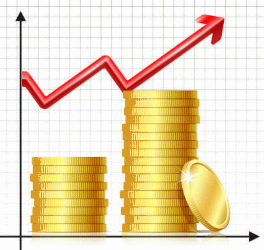 Page 3 
We need some explanations first: i is the interest rate each time it's paid. n is the number of times per year interest is paid. Annually means once a year: n = 1 Semi-annually means twice a year: n = 2 Quarterly means four times a year: n = 4 Monthly means twelve times a year: n = 12 Weekly means fifty-two times a year: n = 52 Daily means three hundred sixty-five times a year: n = 365
Example 1: You deposit $4000 in an account that pays 2% p.a., compounded quarterly, and leave it for 6 years. What amount will you end up with, and how much interest did you earn? A = P(1 + i)b P = $4000 i = 0.02/4 = 0.005 b = 4 x 6 = 24 A = 4000(1 + 0.005)24 A = $4508.64 I = A - P = 4508.64 - 4000 = $508.64 You'll need a scientific calculator to work out A. Example 2: You deposit $2000 in an account that pays 1.5% p.a., compounded monthly, and leave it for 5 years. What amount will you end up with, and how much interest did you earn? P = 2000 i = 0.015/12 = 0.00125 b = 12 x 5 = 60 A = P(1 + i)b A = 2000(1.00125)60 A = $2155.67 I = 2155.67 - 2000 = $155.67 Example 3: You deposit $5000 in an account that pays 1% p.a., compounded daily, and leave it for 2 years. What amount will you end up with, and how much interest did you earn? P = 5000 i = 0.01/365 = 0.0000274 b = 365 x 2 = 730 A = P(1 + i)b A = 5000(1.0000274)730 A = $5,101.02 I = 5,101.02 - 5000 = $101.02 Example 4: You can also do these questions backwards: You will begoing on a cruise in 6 years, and will need $10,000. How much would you have to deposit now into an account that pays 2.5% p.a. compounded semi-annually, left for 6 years, in order to end up with a total amount of $10,000? A = $10,000 P = ? i = 0.025/2 = 0.0125 b = 2 x 6 = 12 A = P(1 + i)b 10,000 = P(1.0125)12 10,000/(1.0125)12 = P $8615.09 = P Notes:
|